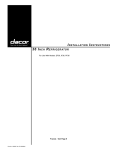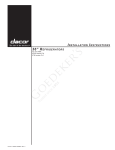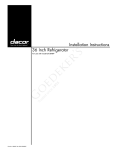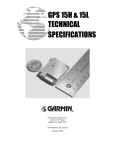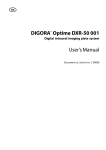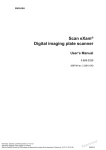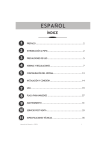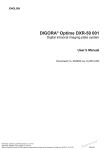Download Dacor EF36BNF Specifications
Transcript
I n stall at i o n I n st r u ct i o n s 36 I n c h R e f r i g e r ato r For Use With Models: EF36BNF, EF36LNF, EF36RNF, PF36BNDF Francis - Voir Page 9 Part No. 106081 Rev. C/13036904 All specifications subject to change without notice Dacor assumes no liability for changes to specifications © 2007 by Dacor, all rights reserved. Table of Refrigerator Safety........................................................................1 Installation Recommendations....................................................1 Design Specifications...................................................................2 Door Swing Dimensions.............................................................. 2 Product Dimensions.....................................................................2 Installation Specifications.........................................................2-3 Tools and Parts............................................................................ 2 Location Requirements................................................................3 Cabinet Layout.............................................................................3 Water Supply Requirements........................................................ 3 Electrical Requirements...............................................................3 Contents Installation Instructions.............................................................4-8 Door and Drawer Front Removal................................................4 Reinstalling the Drawer Front...................................................... 5 Reinstalling the Door(s)..............................................................`5 Connecting the Water Supply...................................................... 6 Plug in Refrigerator...................................................................... 6 Move Unit to Final Position..........................................................7 Leveling.......................................................................................7 Handle Installation ...................................................................... 7 Properly Dispose of Your Old Refrigerator ................................. 7 Installation Check List.................................................................. 8 Refrigerator Safety Your safety and the safety of others are very important. We have provided many important safety messages in this manual and on your appliance. Always read and obey all safety messages. This is the safety alert symbol. This symbol alerts you to potential hazards that can kill or hurt you and others. All safety messages will follow the safety alert symbol and either the word “DANGER” or “WARNING.” These words mean: You can be killed or seriously injured if you don’t immediately follow instructions. DANGER WARNING You can be killed or seriously injured if you don’t follow instructions. All safety messages will tell you what the potential hazard is, tell you how to reduce the chance of injury, and tell you what can happen if the instructions are not followed. WARNING Suffocation Hazard Remove the doors from your old refrigerator. Failure to do so can result in death or brain damage. WARNING Explosion Hazard Keep flammable materials and vapors, such as gasoline, away from the refrigerator. Failure to do so can result in death, explosion, or fire. IMPORTANT SAFETY instructions WARNING: To reduce the risk of fire, electric shock, or injury to persons when using the refrigerator , follow basic precautions, including the following: Plug into a grounded 3 prong outlet. Do not remove ground prong. Do not use an adapter. Do not use an extension cord. Disconnect power before servicing. Replace all parts and panels before operating. Use nonflammable cleaner. Keep flammable materials and vapors, such as gasoline, away from refrigerator. Use two or more people to move and install refrigerator. Disconnect power before installing ice maker (on ice maker kit ready models only). Remove doors from your old refrigerator. Save these instructions Installation Recommendations The importance of the installation of the Dacor refrigerator cannot be overemphasized. Installation should be done by a qualified installer. By reading these instructions carefully, you will make the installation process easier, problem-free and, most importantly, safe. Before you begin the installation process, it is recommended that you read these installation instructions completely. There are key details that you should take special care to observe during the installation process. Any questions or problems with the installation should be directed to your Dacor dealer or the Dacor Customer Service Team at (800) 793-0093. You can also visit our web site at www.Dacor. com. 1 Design Specifications Product Dimensions ◊ The depth from the front of the door (w/o door handles) to the back of the refrigerator chassis is 26 7/8” (683 mm). ◊ The depth of the cabinet less the door is 24 1/8” (613 mm). ◊ The power cord is 60” (1524 mm) long. ◊ The height from the top of the refrigerator to the floor with the leveling legs in the down position is 70 1/8” (1781 mm) ◊ The height from the top of the refrigerator to the floor with the leveling legs in the fully extended position is 71 1/4” (1810 mm) at the front of the unit and 70 11/16” (1796 mm) at the rear of the unit. ◊ The refrigerator width from edge to edge is 35 5/8” (905 mm). Tools Door Swing Dimensions The area to the left and the right of the appliance must permit both doors to open to a minimum of 90°. Allow a minimum of 2 1/2” (64 mm) space between the side of the refrigerator doors and a corner wall. Installation Specifications and IMPORTANT: Parts ◊ Installer: Leave these installation instructions with the homeowner. ◊ Homeowner: Keep these installation instructions for future reference. Save these installation instructions for the local electrical inspector’s use. Location Requirements Your Dacor refrigerator can be recessed in an opening between cabinets or installed at the end of a cabinet run using a side panel to enclose the refrigerator. WARNING Tools needed: Make sure that you have the necessary tools and materials available for a proper installation. ◊ Phillips screwdriver set ◊ Slotted screwdriver set ◊ Torx drive screwdriver set ◊ Provide sufficient length 8’ (2.4 m) to allow for a minimum of a 24” (610 mm) diameter service loop of 1/4” (6 mm) copper tubing for the water line. Explosion Hazard Keep flammable material and vapors, such as gasoline, away from the refrigerator. Failure to do so can result in death, explosion, or fire. IMPORTANT: ◊ Observe all governing codes and ordinances. ◊ To ensure proper ventilation for your refrigerator, allow for a ½” (1.25 mm) space at the top and behind the refrigerator. ◊ Do not install the refrigerator near an oven, radiator or other heat source, nor in a location where the temperature will fall below 55°F (13°C). ◊ Allow a minimum of 2 1/2” (64 mm) space between the side of the refrigerator and an oven or range. ◊ The floor must be able to support the refrigerator’s weight of more than 600 lbs (272 kg), the door panels and the contents of the refrigerator. ◊ Copper tubing cutter ◊ Level - 2’ (.6 m) and 4’ (1.2 m) recommended ◊ Appliance dolly able to support 700 lbs (317 kg) and adequate manpower to handle the weight of the appliance ◊ Various sized pliers ◊ Allen wrench set ◊ 3/8” hex bolt nut driver or socket set ◊ Crescent wrenches ◊ Cordless drill and assorted drill bits ◊ The ceiling height must allow for side tipping radius. ◊ Masonite, plywood, 1/8” pressed fiberboard, cardboard or other suitable material to protect finished flooring ◊ The location should permit doors to open fully. ◊ Appropriate materials to cover and protect the home and its furnishings during installation 2 WARNING Excessive Weight Hazard Use two or more people to move and install the refrigerator. Failure to do so can result in back or other injury. Installation Specifications Cabinet Layout Reverse osmosis water supply ◊ A grounded three prong non-GFCI electrical outlet must be provided and should be in a location that allows the refrigerator to be connected without an extension cord. See “Electrical Requirements” for additional information. ◊ The plumbing for the water line can come through the floor flush to or from the back wall. Install the water valve in a location that allows it to be turned off without moving the refrigerator out in the event the refrigerator or water line requires service. ◊ For model IF36, see document 100504 for instructions on planning and installing integrated front panels. It is available at www.Dacor.com. 36” Min. (914 mm) 70 ½” Min. (1791 mm) IMPORTANT: The pressure of the water supply coming out of a reverse osmosis system going to the water inlet valve of the refrigerator needs to be between 35 and 120 psi (241 and 827 kPa). If a reverse osmosis water filtration system is connected to your cold water supply, the water pressure to the reverse osmosis system needs to be a minimum of 40 to 60 psi (276 to 414 kPa). If the water pressure to the reverse osmosis system is less than 40 to 60 psi (276 to 414 kPa): ■ Check to see whether the sediment filter in the reverse osmosis system is blocked. Replace the filter if necessary. ■ Allow the storage tank on the reverse osmosis system to refill after heavy usage. ■ If your refrigerator has a water filter, it may further reduce the water pressure when used in conjunction with a reverse osmosis system. Remove the water filter. See “Water Filtration System.” If you have questions about your water pressure, call a licensed, qualified plumber. Electrical Requirements A 115 Volt, 60 Hz. AC only 15 or 20 amp fused, grounded electrical supply is required. It is recommended that a separate circuit serving only your refrigerator be provided. Use an outlet that cannot be turned off by a switch. Do not use an extension cord. 16” (406 mm) 30”. (762 mm) 24” (610 mm) Water valve Location Approximate Dimensions Water Valve Location - Approximate Dimensions Water Supply Requirements ◊ All installations must meet local plumbing code requirements. ◊ Use 1/4” (6 mm) copper line to connect the refrigerator to the house cold fresh water supply. ◊ Install a shut off valve between the refrigerator and water supply. The shut off valve should be a drilled saddle valve. See the diagram above for recommended location. ◊ Do not use a piecing type or 3/16” (4.76 mm) saddle valve which will reduce water flow and clog more easily. ◊ Allow a minimum of 24” (610 mm) diameter service loop of copper tubing outside the wall or floor for easy connection to the water supply. 12” (305 mm) 12” (305 mm) Electrical Location - Approximate Dimensions Cold water supply Connect the ice maker to a cold water line with water pressure between 35 and 120 psi. If you have any questions about your water pressure, call your utility company. 3 Installation Instructions IMPORTANT: If you receive a damaged product, immediately contact your dealer or builder. Do not install or use a damaged appliance. Door and Drawer Front Removal Some installations require door and drawer front removal before transporting the refrigerator through doorways to the location where it will be used. WARNING TO REMOVE THE DRAWER FRONT: 1. Pull the freezer drawer completely open. 2. Tilt the lower basket forward and lift to remove. 3. Loosen the four (4) screws attaching the drawer brackets to the drawer front as shown below. Electric Shock Hazard Disconnect power before removing doors. Failure to do so can result in death or electrical shock. NOTE: Loosen the screws only three to four turns. Do not remove the screws from the drawer front. TO REMOVE THE DOOR: 1. Unplug the power cord from the power source. 2. Remove the toe grille. Loosen screws on both sides of the drawer front. Hinge Cover 3. Remove the top hinge cover from the refrigerator door by removing the Phillips screw. Retain the screw and cover for later use. Top Hinge 4. Unscrew the 5/16” hex head screws from the top hinge. Remove the hinge and retain it and all screws for later use. 5. On 3 door (french door) models, disconnect the wiring plug located on top of the left top hinge by wedging a flat-blade screwdriver between the two sections. 6. Lift the refrigerator door(s) from center hinge pin. Wiring Plug 7. Remove the Phillips screws that hold the center hinge in place. Remove the hinge and retain it and all screws for later use. Center Hinge 4 4. Lift the drawer front upward and off the screws. Reinstalling Installation Instructions the Drawer Front After the moving the refrigerator to the location where it will be used, reinstall the door(s) and freezer drawer front. 1. Slide the screws on the back of the drawer front into the slots in the drawer brackets on both sides. You may need to move the bottom of the bracket around slightly to get the slot to line up with the screw. Reinstalling the Door(s) Install the hinge assemblies: 1.Install the top hinge loosely using the existing 5/16” hex head screws. 2.Install the center hinge using the existing Phillips screws. Top Hinge Center Hinge 3. Place the hinge side of the refrigerator door on the center hinge pin. 2. Tighten the four front panel screws completely. Do not overtighten. 4. While holding the refrigerator door upright, tighten down the top hinge with a 5/16” hex head driver. Hinge Pin 3. Place the freezer basket back onto the drawer slides. 5. On 3 door (french door) models, reconnect the wiring plug located on top of the left top hinge. Wiring Plug 6. Replace the hinge cover using the existing Phillips screw. Hinge Cover 5 Connecting Installation Instructions the Materials Needed: Water Supply 1 2 • 1⁄4” outer diameter flexible copper tubing • Shut-off valve (requires a 1⁄4” hole to be drilled into water supply line before valve attachment) • Adjustable wrench • 1⁄4” hex nut driver 6.Slide the brass nut over the sleeve and screw it into the inlet port. 7.Place an adjustable wrench on the nut (1) attached it to the plastic waterline. Maintain position. 1 2 8.Using a second adjustable wrench, turn the lower nut (2) counterclockwise and fully tighten it while holding the upper nut in place. Do not overtighten. 1.Unplug the refrigerator from the electrical outlet. 2.Create service loop with copper tubing (minimum 2’ diameter). Avoid kinks in the copper tubing when bending it into a service loop. Do not use plastic tubing. 9.Pull on the tubing to confirm the connection is secure. Connect the tubing to the frame with the water tubing clamp (C). 10. Turn on the water supply. Check for leaks and correct if necessary. Continue to observe the water supply connection for two to three hours prior to moving the refrigerator to its permanent location. Monitor the water connection for 24 hours. Correct leaks if necessary. C 3.Remove the plastic cap from water valve inlet port. Plug in Refrigerator WARNING 4.Place the brass nut (A) and sleeve (B) on the end of the copper tube as illustrated. Reminder: Do not use an old sleeve. The nut and sleeve are provided in the use and care packet. 5.Place the end of the copper tubing into the water valve inlet port. Shape the tubing slightly. Do not kink the tubing so that it feeds straight into the inlet port. 6 B A B A Electric Shock Hazard Plug the refrigerator into a grounded 3-prong outlet. Do not remove ground prong. Do not use an adapter. Do not use and extension cord. Failure to follow these instructions can result in death, fire, or electrical shock. Plug the refrigerator into a grounded three prong outlet. NOTE: Allow 24 hours to produce the first batch of ice. Discard the first three batches of ice produced. Allow three days to completely fill the ice container. Move Unit Installation Instructions to Final Position When Moving Your Refrigerator: Your refrigerator is heavy. When moving the refrigerator for cleaning or service, be sure to protect the floor. Always pull the refrigerator straight out when moving it. Do not wiggle or “walk” the refrigerator when trying to move it. Floor damage could occur. Leveling 1.Remove the base grille. Grasp the grille firmly an pull it toward you. Handle Installation • Some units do not come with the handle installed to allow the customer to choose the handle style. Optional handle kits are also available for other models that come with the handle already installed. See the use and care manual for a list of available handle kits. • The installation instructions for the handle are included with the kit. Properly Dispose Refrigerator of Your Old WARNING Suffocation Hazard Remove doors from your old refrigerator. Failure to do so can result in death or brain damage. 2.Using a 1/4” hex driver, turn the leveling screw on each side to raise or lower that side of the refrigerator. NOTE Having someone push against the top of the refrigerator takes some weight off the adjustment screws and rollers. Doing so makes it easier to turn the screws. • To raise, turn the adjustment screw clockwise. • To lower, turn the adjustment screw counter-clockwise. IMPORTANT: Child entrapment and suffocation are not problems of the past. Junked or abandoned refrigerators are still dangerous even if they sit out for “just a few days.” If you are getting rid of your old refrigerator, please follow the instructions below to help prevent accidents. Before you throw away your old refrigerator or freezer: • Take off the doors. • Leave the shelves in place so children may not easily climb inside. 3.Open the door again to make sure that it closes as easily as you like. If not, tilt the refrigerator slightly more to the rear by turning both adjustments screws clockwise. It may take several more turns, and you should turn both adjustment screws the same amount. 4.Replace the base grill. 7 Installation Instructions Installation Checklist The importance of the proper installation of your Dacor refrigerator cannot be overemphasized. Proper installation is the responsibility of the homeowner. IMPORTANT: To ensure a safe and proper installation, the following checklist should be competed by the installer to ensure that no part of the installation has been overlooked. Any questions or problems with this installation should be directed to your Dacor dealer or the Dacor Customer Service Team at (800) 793-0093 or email [email protected]. You may also visit our web site at www.Dacor.com. Are all the leveling legs extended down to make contact with the floor? Is the unit level? Is the power cord plugged into a properly grounded dedicated three prong, grounded outlet, which had been installed in accordance with all applicable electrical codes? Is the water supply connected? Have you checked for leaks? Has the base grill been installed properly? Has the old refrigerator been disposed of safely and properly? Have any problems been noted on the warranty card or during the on-line activation? Has the warranty been activated online or has the warranty card been filled out and mailed? If you need service, be sure to have the model and serial numbers when you call. You’ll find these numbers on the serial number plate, located on the right hand side of the fresh food compartment. Contact a Dacor authorized service representative, a Dacor dealer, or the Dacor Customer Service Team at (800) 793-0093. 8












